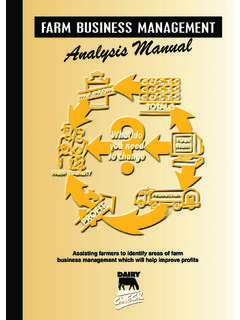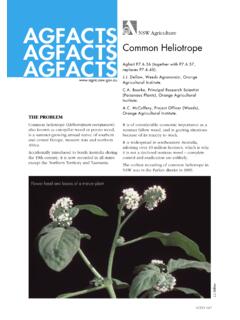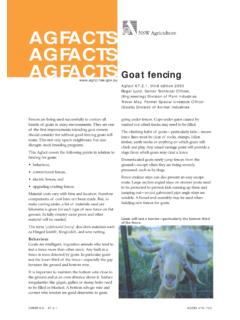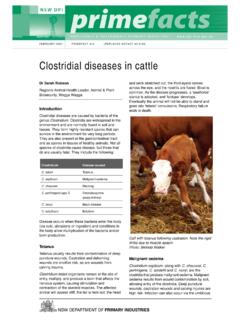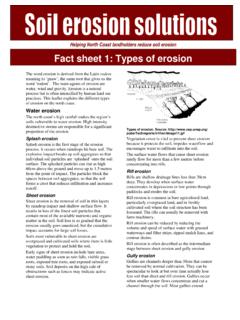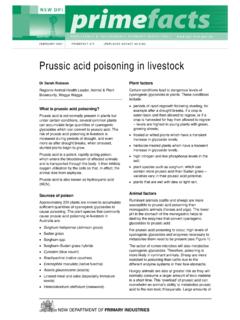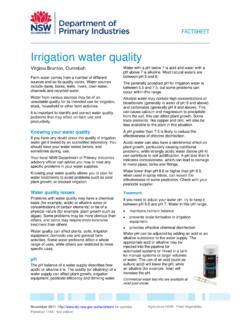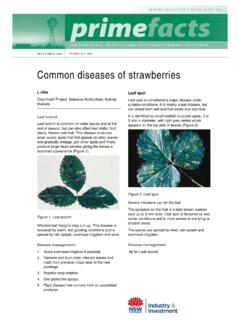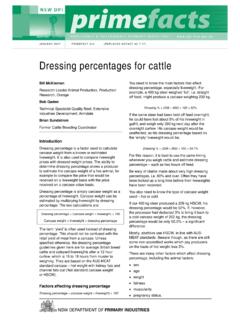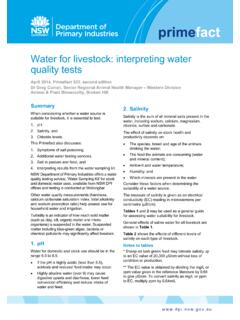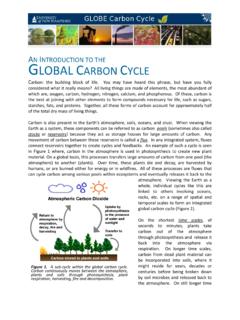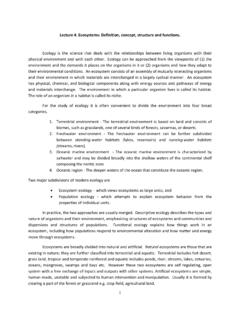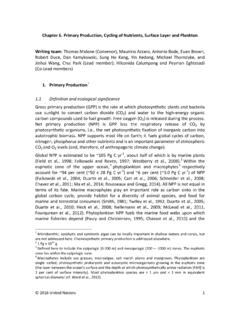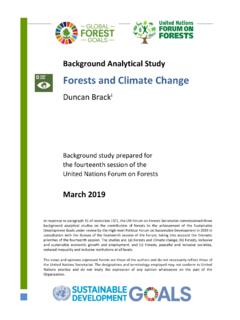Transcription of Increasing soil organic carbon of agricultural land
1 JANUARY 2008 PRIMEFACT 735 Increasing soil organic carbon of agricultural landDr Yin Chan Principal Research Scientist (Soils), Richmond Increasing soil organic carbon (SOC) can improve soil health and can help to mitigate climate change. Although there is a limit on the amount of organic carbon that can be stored in soils, the large losses in the past means that many Australian agricultural soils have the potential for large increases. SOC levels are influenced by management practices. Many management practices that are effective in Increasing SOC are also effective in improving crop and pasture yields. The actual amount of soil carbon that can be stored is dependent on the farming system (management practices), soil type and climatic conditions, as well as the initial soil carbon level of the site. What is soil organic carbon ? soil organic carbon (SOC) is the carbon associated with soil organic matter. soil organic matter is the organic fraction of the soil that is made up of decomposed plant and animal materials as well as microbial organisms, but does not include fresh and un-decomposed plant materials, such as straw and litter, lying on the soil surface.
2 soil carbon can also be present in inorganic forms, lime or carbonates in some soils in the drier areas. carbon cycle and soil carbon pools SOC forms part of the natural carbon cycle (Figure 1). organic material is manufactured by plants through the process of photosynthesis, using atmospheric carbon dioxide and water as raw materials. The plants (and the animals as part of the food chain) eventually die and return to the soil where they are decomposed and recycled. Figure 1. soil organic carbon forms part of the natural carbon cycle (see Table 1). (White arrows indicate additional human outputs) Minerals are released into the soil and carbon dioxide back to the atmosphere. There is a continuous turnover of organic carbon materials in soil , and SOC is not a uniform material but rather a complex mixture of organic compounds at different stages of decomposition. It is convenient to divide total SOC into different pools dependent on their ease of decomposition, namely labile pool, slow pool and inert pool (Figure 2).
3 The labile pool includes all the freshly added plant and animal residues as well as micro-organisms. As these are easily decomposed, they are labile. The slow pool includes well- decomposed organic materials, the humus. The inert pool refers to the fraction that is old, resistant to further breakdown and represents the products of the last stage of decomposition, charcoal. Therefore soils differ not only in total SOC but also in the composition of the different SOC pools. Figure 2 shows the SOC level and its composition of a soil which has been under no-tillage and stubble retention (SOC = %) and the same soil which has been under 3 pass tillage and stubble burning (SOC = %) after 19 years. Most of the SOC difference between the two soils is the loss of some of the labile fraction from the tilled soil . As a result the slow and inert pools make up a larger proportion of the total SOC of the 3 pass tillage and stubble burnt soil .
4 Figure 2. soil organic carbon levels (sizes of the circles) and the three different carbon pools (individual slices) of the same soil under two different management practices in Wagga Wagga. Importance of soil organic carbon in agriculture soil organic carbon as the basis of soil fertility soil organic carbon is important for all three aspects of soil fertility, namely chemical, physical and biological fertility. Nutrient availability. Decomposition of soil organic matter releases nitrogen, phosphorus and a range of other nutrients for plant growth. soil structure and soil physical properties. SOC promotes soil structure by holding the soil particles together as stable aggregates improves soil physical properties such as water holding capacity, water infiltration, gaseous exchange, root growth and ease of cultivation. Biological soil health. As a food source for soil fauna and flora, soil organic matter plays an important role in the soil food web by controlling the number and types of soil inhabitants which serve important functions such as nutrient cycling and availability, assisting root growth and plant nutrient uptake, creating burrows and even suppressing crop diseases.
5 As a buffer against toxic and harmful substances. soil organic matter can lessen the effect of harmful substances toxins, and heavy metals, by acting as buffers, sorption of toxins and heavy metals, and Increasing degradation of harmful pesticides. soil organic carbon as a sink for atmospheric carbon As a result of human activities releasing carbon dioxide into the atmosphere (particularly fossil fuel consumption and land use practices), the carbon pool in the atmosphere has increased and the elevated carbon dioxide is considered to be a contributory factor to the danger of global warming and climate change. However, SOC is a very important component of the global carbon cycle (see Figure 1 and Table 1). It is the largest component of the terrestrial carbon pools, approximately twice the amount of carbon in the atmosphere and in vegetation. If more carbon is stored in the soil as organic carbon , it will reduce the amount present in the atmosphere, and therefore help to alleviate the problem of global warming and climate change.
6 This process of storing carbon in soil is called soil carbon sequestration. Table 1. carbon pool size and changes due to human activities carbon pool size Vegetation 610Gt* Atmosphere 750 Gt soil 1,580 Gt Ocean 39,000 Gt carbon changes due to human activities Fossil fuel use + Gt/year land Use + Gt/year Rate of carbon increase in the atmosphere + Gt/year Source: The carbon cycle, climate and the long term effects of fossil fuel burning , J F Kastings, Consequences Vol 4, No 1, 1998. *Gt = Gigatonne, which is 1000 million metric tonnes soil organic carbon is the basis of sustainable agriculture PRIMEFACT 735, Increasing soil organic carbon OF agricultural land 2 How much carbon can be stored in soils?
7 There are a whole range of SOC levels in different soils. For instance, for the surface soils, SOC ranges from about 10% in the alpine soils to less than in the desert soils. The amount of SOC stored in the soil profile can be considerable. For example, if there is 1% SOC over 30 cm soil depth, the amount of SOC stored over 1 hectare of land can weigh about 42 tonnes (see last section). Usually, the surface layer has the highest level of SOC which decreases with depth down the soil profile. The actual amount of SOC present in a soil is dependent on a number of factors. Factors affecting soil carbon level soil carbon levels are determined by factors such as rainfall, temperature, vegetation and soil type and reach equilibrium values associated with individual systems and locations. However, these equilibria are disturbed when areas are cleared and used for agricultural production. Globally, clearing natural vegetation for agriculture results in large reductions in SOC levels and further declines may occur due to management practices (Figure 3).
8 In Australia, it has been estimated that, in many areas, soil carbon levels have dropped by up to 50% compared to pre- agricultural periods. Most of the reduction in SOC occurs in the surface soil layer, 0 10 cm. Therefore, soil carbon levels of agricultural soils are lower than corresponding soils under natural vegetation. This difference in SOC indicates the potential for soil carbon storage. As indicated in Figure 3, rapid decline in SOC occurs when land under natural vegetation is cleared and converted to agriculture but restoration of SOC level ( under reduced tillage) occurs at a much slower rate. In agricultural systems, soil carbon levels tend to be variable and dependent on management practices. The change in SOC is determined by the balance of carbon inputs over losses. Management practices that reduce soil organic carbon Some management practices, such as fallowing, cultivation, stubble burning or removal, and overgrazing can reduce SOC by reducing inputs to the soil , Increasing the decomposition of soil organic materials, or both.
9 Figure 3. Historical change in SOC as a result of agricultural development, showing soil carbon sequestration potential Cultivation. Cultivation operations can expose SOC and increase losses by decomposition and erosion. Historically, excessive cultivation using inappropriate implements resulted in soils being over-worked , and the consequent loss of SOC has caused many land degradation problems such as erosion and soil structural decline. Fallowing. In the past, keeping the soil bare was a common cropping practice. Fallowing was maintained by repeated cultivation for weed control. SOC declines rapidly under fallowing because of the increased decomposition of organic matter due to the cultivation operations as well as the higher soil moisture conditions prevailing in the fallowed soils. Management practices that increase soil organic carbon There are a wide range of management options and farming practices that can increase SOC levels by either Increasing inputs or decreasing losses, stubble retention (Table 2).
10 Inputs can also be increased by direct additions of organic materials, composts, manure and other recycled organic materials. The challenge is to turn agricultural soils into effective carbon sinks Practices leading to increased productivity of crops and pastures In theory, any management practice that can increase production from an area of land should lead to increased SOC storage because of the increase in carbon inputs. Farmers are familiar with practices such as fertiliser application, improved rotations, improved cultivars and irrigation which can lead to large yield increases. Productivity increases can also be achieved by crop intensification practices such as double cropping, opportunity cropping and multiple PRIMEFACT 735, Increasing soil organic carbon OF agricultural land 3 Table 2. Management practices that can increase soil organic levels of agricultural soils cropping.
